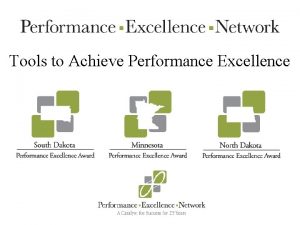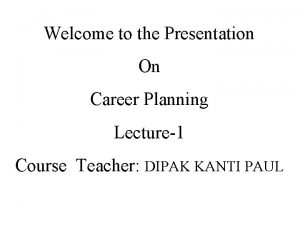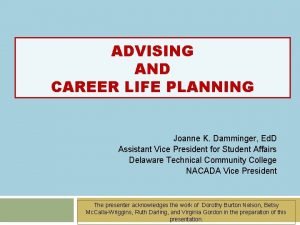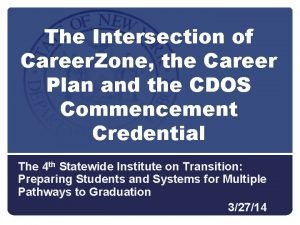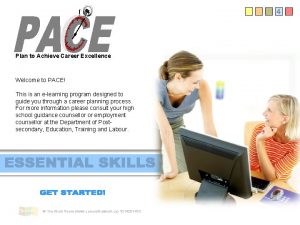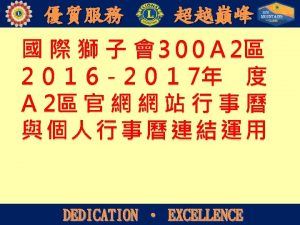3 Plan to Achieve Career Excellence Welcome to

















- Slides: 17

3 Plan to Achieve Career Excellence Welcome to PACE! This is an e learning program designed to guide you through a career planning process. For more information please consult your high school guidance counsellor or employment counsellor at the Department of Post secondary, Education, Training and Labour. © The Work Room (www. careersthatwork. ca) 10142014 SC

Welcome to Module 3: The Action Plan This represents the third step of a five part career planning process; 1 Identifying Interests 2 Researching Careers 3 The Action Plan 4 Workplace Essential Skills 5 Job Search Strategies Before you start, you should have developed a list of interests (Module 1) and conducted some research on potential career options (Module 2). Caution: If you have not completed these steps, any decisions you make through this module may not result in the outcome you had intended. © The Work Room (www. careersthatwork. ca) 10142014 SC

The 6 Post-secondary Destinations At this point in your career plan, you need to start acting on the information you have collected. Your research (Step 2) should have identified one or more career options that you would like to pursue. The questions is; How do you put your career plan into action? You need to select a path that leads you to your desired career goal. You have six paths to choose from (see diagram on the right). Each path is equally effective provided it compliments your career plan and moves you closer to your ultimate career goal. As this module will discuss, these options do not exist in isolation. Frequently, people will select a combination that works for them over their working career. Now we will examine each of these options to assist you in the career decision making process. © The Work Room (www. careersthatwork. ca) 10142014 SC Apprenticeship Military Direct to Work University Community College Private Training Schools

Apprenticeship There are more than one million people who work in the over 200 designated trades in Canada. There are 50 designated trades in New Brunswick. Generally, the trades fall within 4 major categories; 1. Construction electricians, carpenters, plumbers, pipefitters, welders, heavy equipment operators, painters, etc. 2. Transportation automotive service technicians, aviation technicians, automotive painters, fuel/electrical systems technicians, etc. 3. Manufacturing tool & die makers, industrial mechanics (millwrights), precision metal fabricators, etc. 4. Service horticulturalists, chefs, florists, etc. (Source: http: //www. careersintrades. ca). © The Work Room (www. careersthatwork. ca) 10142014 SC

Apprenticeship If you are thinking about a career in the trades, the New Brunswick Apprenticeship and Certification Program is worth consideration http: //www 2. gnb. ca/content/gnb/en/departments/post secondary_education_training_and_labour/Skills/content/App renticeship. And. Trades. html. About 80 percent of an apprentice's training takes place on the job; the remaining 20 percent involves technical training at a post secondary training establishment. Benefits: Earn as you learn. Apprenticeship is the only career route where one can earn 50 to 90 percent of a journeyperson's wages while learning new skills on the job. Low education costs. Financial assistance may be available to help pay for tuition fees, text books and living expenses while in school. Mobility. Standardized certification guidelines across the country apply to many of the occupations/trades. Meaning you can work anywhere in Canada without having to further prove acquired qualifications. © The Work Room (www. careersthatwork. ca) 10142014 SC

Military Canadian Forces members serve Canada by defending its values, interests and sovereignty at home and abroad. Canadian Forces personnel belong to air, land, sea and special operations components. Members serve either full time in the Regular Force or part time in the Reserves. When you join the Regular Force, you are signing on for several years of service. Members of the Reserves are part time Military personnel who get a sense of what it might be like to pursue a Military career, without making a long term commitment. Did you know? In 2014, there are roughly 68, 000 Canadians serving in the Regular Forces and 27, 000 in the Primary Reserves. There also nearly 70 types of different career opportunities available for civilians. http: //www. forces. gc. ca/en/index. page © The Work Room (www. careersthatwork. ca) 10142014 SC

Military Benefits: Guaranteed employment. Provided you pass Basic Training and the requirements of the applicable military occupation training, you are guaranteed employment through the duration of your initial contract. Many Canadian Forces members are offered contract renewals until retirement. On the job training. Many of the skills and training obtained through the military transfer into the private sector. You may even acquire valuable skills that you cannot get anywhere else making you a definite asset to employers. Subsidized education. If you qualify for service in the Regular Forces, you could have your post secondary education subsidized. You can find everything you want to know about the Canadian Armed Forces at http: //www. forces. gc. ca/en/index. page © The Work Room (www. careersthatwork. ca) 10142014 SC

University Canadian universities offer more than 10, 000 undergraduate and graduate degree programs as well as professional degree programs and certificates. Association of Universities and Colleges in Canada: http: //www. aucc. ca/ School. Finder: http: //www. schoolfinder. com For some professions, a university degree is the only way to pursue the career (lawyers, doctors, engineers). University offers an opportunity for a student to experience different ideas, disciplines and develop a level of maturity and adaptable skill set that is desirable for many employers. It offers an opportunity for students to learn practical career information along with knowledge to assist them in their personal life pursuits. © The Work Room (www. careersthatwork. ca) 10142014 SC

University Benefits; Higher earnings. University graduates earn about 50 percent more than those who have not completed a postsecondary degree and that difference grows over time. More employment opportunities. The unemployment rate is around four percent for university graduates, six percent for college graduates and nine percent for high school graduates. Career versatility. Refinement of many essential workplace skills (Module 4) that are in demand by all employers. © The Work Room (www. careersthatwork. ca) 10142014 SC

Private Training Schools Private sector trainers that offer programs that are intended to prepare an individual for a specific occupation or are considered "employment enhancing" are required to register the organization, programs / courses and teacher instructors in accordance with the New Brunswick Private Occupational Training Act and Regulation. http: //www 2. gnb. ca/content/gnb/en/departments/post secondary_education_training_and_labour/Skills/conte nt/Institutions/Private. Career. Colleges. html The Act makes provision for specific exemptions, such as programs of less than twenty one hours and programs delivered via the internet or by correspondence. In addition, organizations offering religious based training or flight training are not required to register, at the present time. Although this registration requirement does provide some basic protection to you, the consumer, it does not certify the quality of the training, or the ethics or competence of the training organizations. It is your responsibility to check these things out yourself. © The Work Room (www. careersthatwork. ca) 10142014 SC

Private Training Schools Benefits: Very specialized. Private colleges often work closely with business to deliver skills specific to employer's needs. This helps a graduate's employability as they have the exact skills that companies in the specialized field are seeking. Low student to instructor ratios. More personalized learning and one on one instruction. Client-focused. Students are regarded as clients and the training institution's success is linked to their graduate's success. They are motivated to help you succeed in your training. Flexible training. There may be more flexible training options available than with other post secondary institutions (online, correspondence, part time, etc) © The Work Room (www. careersthatwork. ca) 10142014 SC

Community Colleges and technical institutes are dynamic institutions constantly changing to meet the economic and social needs of the communities they serve. Their uniqueness lies in their combination of employer centered curricula within extremely comprehensive learning institutions which respond to national economic policy. Significant features of Canadian colleges are: • business/industry linkages • technical and vocational teacher and trainer training • industry-based curriculum development • co-operative education programs Association of Community Colleges: http: //www. accc. ca/ © The Work Room (www. careersthatwork. ca) 10142014 SC

Community College The New Brunswick Community College offers over 100 programs in the following New Brunswick locations; Saint John, Fredericton, Moncton, Miramichi, St. Andrews and Woodstock. http: //www. nbcc. ca. Benefits: Get into the workforce sooner. Many programs are condensed into 2 3 year programs meaning you can complete your training quickly and start making money. Low education costs. $2, 600 for a 40 week program (except for academic upgrading and industry customized programs). You may also qualify for grants, loans or scholarships to offset costs. High post-graduate employment rates. The 2013 NBCC Graduate Follow up Survey results indicate that graduates have a success rate of finding a career in their intended career field 81% of the time. © The Work Room (www. careersthatwork. ca) 10142014 SC

Direct-to-Work At many points in your career you will select this option. When you select it depends on your career goals and your financial situation. Job search tools and strategies are covered in Module 5: Job Search Strategies. Did you know? Canada's labour market is facing very unique challenges as 46% of baby boomers (people born between 1946 and 1966) are close to their retirement or pre retirement years. This means that it is becoming easier for people to enter the workforce as well as find more varied opportunities across many industrial sectors. http: //www. hrsdc. gc. ca/ © The Work Room (www. careersthatwork. ca) 10142014 SC

Putting it all Together Summary of Module 3: The 6 Post-secondary Destinations This step is about providing you with options to start putting your career plan into action. The research you conducted in Module 2 should have generated some post secondary training options for you; Apprenticeship Military Community College Private Training School University Direct to Work Which one you choose will depend on factors such as availability of training, admission requirements, finances, location, etc. . Remember, the path you choose should compliment your career goal and fit into a career plan you can commit to. © The Work Room (www. careersthatwork. ca) 10142014 SC Did you know? It is difficult to find statistics that define and track career changes. However, career counselling organizations estimate that people change careers on average, as high as seven times.

Putting it all Together A career planning workbook and career coaching guide for parents are available from a Work Room coordinator as part of the PACE e learning modules. In the workbooks are exercises that you can complete and track your career plan (an example is shown on the right). There are many ways to construct an action plan that will get you on the path to achieving your career goal. Just make sure that you DO SOMETHING instead of just researching and thinking about your future. Be prepared to be flexible. You may need to adjust time frames, select a different destination, a different career goal, or even rework major parts of your plan. This is normal. Your career plan is part of your life and it really is important to enjoy and be excited about the journey, © The Work Room (www. careersthatwork. ca) 10092014 SC

Congratulations! You have completed Module 3: The Six Postsecondary Destinations of the PACE e learning series. You can revisit this module at any time to review the material or visit website links and resources that it contains. If you are working on your career plan with an employment counsellor, guidance counsellor or career coach, you should discuss with them the information contained in this module before proceeding to the next module in the series. Next module: Workplace Essential Skills 4 © The Work Room (www. careersthatwork. ca) 10142014 SC
 How to achieve performance excellence
How to achieve performance excellence 17 career clusters
17 career clusters Formulas for career success: résumés - assessment
Formulas for career success: résumés - assessment Wise men three clever are we
Wise men three clever are we Pretest: developing an academic and career plan
Pretest: developing an academic and career plan Career planning presentation
Career planning presentation Tectura hong kong
Tectura hong kong Career plan for students
Career plan for students Career development plan by using graphic organizer
Career development plan by using graphic organizer Career zone ny
Career zone ny Email to an exchange student
Email to an exchange student Achievethecore
Achievethecore Lexile scale
Lexile scale I asked god for strength that i might achieve
I asked god for strength that i might achieve If you can imagine it you can achieve it
If you can imagine it you can achieve it Achieve 3000.com login
Achieve 3000.com login Is it time to raise pay achieve 3000 answers
Is it time to raise pay achieve 3000 answers How to achieve optimal health and wellness
How to achieve optimal health and wellness
